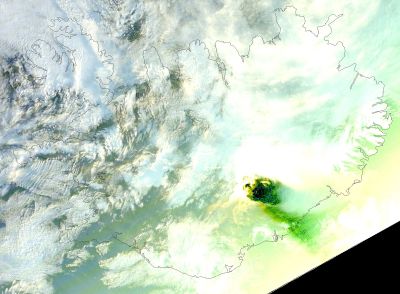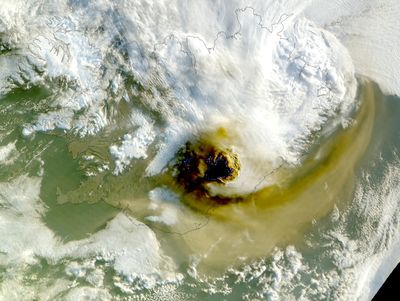Determination of time- and height-resolved volcanic ash emissions and their use for quantitative ash dispersion modeling: the 2010 Eyjafjallajökull eruption
A. Stohl1, A. J. Prata1, S. Eckhardt1, L. Clarisse2, A. Durant1,3,4, S. Henne5, N. I. Kristiansen1, A. Minikin6, U. Schumann6, P. Seibert7, K. Stebel1, H. E. Thomas4, T. Thorsteinsson8, K. Třrseth1, and B. Weinzierl6
1Norwegian Institute for Air Research (NILU), Kjeller, Norway, 2Spectroscopie de l'Atmosphére, Service de Chimie Quantique et Photophysique, Université Libre de Bruxelles, Brussels, Belgium, 3Centre for Atmospheric Science, Department of Chemistry, University of Cambridge, Lensfield Road, Cambridge, UK, 4Department of Geological Engineering and Sciences, Michigan Technological University, Houghton, MI, USA, 5Empa, Swiss Federal Laboratories for Materials Science and Technology, Dübendorf, Switzerland, 6Deutsches Zentrum für Luft- und Raumfahrt, Institut für Physik der Atmosphäre, Oberpfaffenhofen, Germany, 7Institute of Meteorology, University of Natural Resources and Life Sciences, Vienna, Austria, 8Institute of Earth Sciences, University of Iceland, Reykjavik, Iceland
Abstract. The April–May, 2010 volcanic eruptions of Eyjafjallajökull, Iceland caused significant economic and social disruption in Europe whilst state of the art measurements and ash dispersion forecasts were heavily criticized by the aviation industry. Here we demonstrate for the first time that large improvements can be made in quantitative predictions of the fate of volcanic ash emissions, by using an inversion scheme that couples a priori source information and the output of a Lagrangian dispersion model with satellite data to estimate the volcanic ash source strength as a function of altitude and time. From the inversion, we obtain a total fine ash emission of the eruption of 8.3 ± 4.2 Tg for particles in the size range of 2.8–28 μm diameter. We evaluate the results of our model results with a posteriori ash emissions using independent ground-based, airborne and space-borne measurements both in case studies and statistically. Subsequently, we estimate the area over Europe affected by volcanic ash above certain concentration thresholds relevant for the aviation industry. We find that during three episodes in April and May, volcanic ash concentrations at some altitude in the atmosphere exceeded the limits for the "Normal" flying zone in up to 14 % (6–16 %), 2 % (1–3 %) and 7 % (4–11 %), respectively, of the European area. For a limit of 2 mg m−3 only two episodes with fractions of 1.5 % (0.2–2.8 %) and 0.9 % (0.1–1.6 %) occurred, while the current "No-Fly" zone criterion of 4 mg m−3 was rarely exceeded. Our results have important ramifications for determining air space closures and for real-time quantitative estimations of ash concentrations. Furthermore, the general nature of our method yields better constraints on the distribution and fate of volcanic ash in the Earth system.
Paper (PDF, 2220 KB)
Citation: Stohl, A., Prata, A. J., Eckhardt, S., Clarisse, L., Durant, A., Henne, S., Kristiansen, N. I., Minikin, A., Schumann, U., Seibert, P., Stebel, K., Thomas, H. E., Thorsteinsson, T., Třrseth, K., and Weinzierl, B.: Determination of time- and height-resolved volcanic ash emissions and their use for quantitative ash dispersion modeling: the 2010 Eyjafjallajökull eruption, Atmos. Chem. Phys., 11, 4333-4351, doi:10.5194/acp-11-4333-2011, 2011.
Hlekkur á greinina: http://www.atmos-chem-phys.net/11/4333/2011/acp-11-4333-2011.html






 apalsson
apalsson
 gattin
gattin
 vulkan
vulkan
 hoskibui
hoskibui
 svatli
svatli




